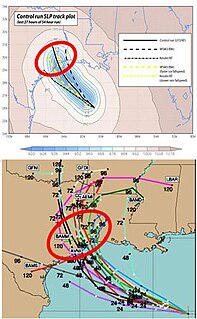Related Research Articles

The European Centre for Medium-Range Weather Forecasts (ECMWF) is an independent intergovernmental organisation supported by most of the nations of Europe. It is based at three sites: Shinfield Park, Reading, United Kingdom; Bologna, Italy; and Bonn, Germany. It operates one of the largest supercomputer complexes in Europe and the world's largest archive of numerical weather prediction data.

The Meteorological Office, abbreviated as the Met Office is the United Kingdom's national weather service. It is an executive agency and trading fund of the Department for Business, Energy and Industrial Strategy and is led by CEO Penelope Endersby, who took on the role as Chief Executive in December 2018 and is the first woman to do so. The Met Office makes meteorological predictions across all timescales from weather forecasts to climate change.
HIRLAM, the High Resolution Limited Area Model, is a Numerical Weather Prediction (NWP) forecast system developed by the international HIRLAM programme.

Numerical weather prediction (NWP) uses mathematical models of the atmosphere and oceans to predict the weather based on current weather conditions. Though first attempted in the 1920s, it was not until the advent of computer simulation in the 1950s that numerical weather predictions produced realistic results. A number of global and regional forecast models are run in different countries worldwide, using current weather observations relayed from radiosondes, weather satellites and other observing systems as inputs.

Ensemble forecasting is a method used in or within numerical weather prediction. Instead of making a single forecast of the most likely weather, a set of forecasts is produced. This set of forecasts aims to give an indication of the range of possible future states of the atmosphere. Ensemble forecasting is a form of Monte Carlo analysis. The multiple simulations are conducted to account for the two usual sources of uncertainty in forecast models: (1) the errors introduced by the use of imperfect initial conditions, amplified by the chaotic nature of the evolution equations of the atmosphere, which is often referred to as sensitive dependence on initial conditions; and (2) errors introduced because of imperfections in the model formulation, such as the approximate mathematical methods to solve the equations. Ideally, the verified future atmospheric state should fall within the predicted ensemble spread, and the amount of spread should be related to the uncertainty (error) of the forecast. In general, this approach can be used to make probabilistic forecasts of any dynamical system, and not just for weather prediction.

The Global Forecast System (GFS) is a global numerical weather prediction system containing a global computer model and variational analysis run by the United States' National Weather Service (NWS).

The Deutscher Wetterdienst or DWD for short, is the German Meteorological Service, based in Offenbach am Main, Germany, which monitors weather and meteorological conditions over Germany and provides weather services for the general public and for nautical, aviational or agricultural purposes. It is attached to the Federal Ministry of Transport and Digital Infrastructure. The DWDs principal tasks include warning against weather-related dangers and monitoring and rating climate changes affecting Germany. The organisation runs atmospheric models on their supercomputer for precise weather forecasting. The DWD also manages the national climate archive and one of the largest specialised libraries on weather and climate worldwide.

An atmospheric model is a mathematical model constructed around the full set of primitive dynamical equations which govern atmospheric motions. It can supplement these equations with parameterizations for turbulent diffusion, radiation, moist processes, heat exchange, soil, vegetation, surface water, the kinematic effects of terrain, and convection. Most atmospheric models are numerical, i.e. they discretize equations of motion. They can predict microscale phenomena such as tornadoes and boundary layer eddies, sub-microscale turbulent flow over buildings, as well as synoptic and global flows. The horizontal domain of a model is either global, covering the entire Earth, or regional (limited-area), covering only part of the Earth. The different types of models run are thermotropic, barotropic, hydrostatic, and nonhydrostatic. Some of the model types make assumptions about the atmosphere which lengthens the time steps used and increases computational speed.
In weather forecasting, model output statistics (MOS) is a multiple linear regression technique in which predictands, often near-surface quantities, are related statistically to one or more predictors. The predictors are typically forecasts from a numerical weather prediction (NWP) model, climatic data, and, if applicable, recent surface observations. Thus, output from NWP models can be transformed by the MOS technique into sensible weather parameters that are familiar to a layperson.

The Norwegian Meteorological Institute, also known internationally as MET Norway, is Norway's national meteorological institute. It provides weather forecasts for civilian and military uses and conducts research in meteorology, oceanography and climatology. It is headquartered in Oslo and has offices and stations in other cities and places. It has around 500 full-time staff and was founded in 1866.
The Global Environmental Multiscale Model (GEM), often known as the CMC model in North America, is an integrated forecasting and data assimilation system developed in the Recherche en Prévision Numérique (RPN), Meteorological Research Branch (MRB), and the Canadian Meteorological Centre (CMC). Along with the NWS's Global Forecast System (GFS), which runs out to 16 days, the ECMWF's Integrated Forecast System (IFS), which runs out 10 days, the Naval Research Laboratory Navy Global Environmental Model (NAVGEM), which runs out eight days, and the UK Met Office's Unified Model, which runs out to six days, it is one of the five predominant synoptic scale medium-range models in general use.
The European Flood Awareness System is a European Commission initiative to increase preparedness for riverine floods across Europe.
The Integrated Forecasting System (IFS) is a global numerical weather prediction system jointly developed and maintained by the European Centre for Medium-Range Weather Forecasts (ECMWF) based in Reading, England, and Météo-France based in Toulouse. The version of the IFS run at ECMWF is often referred to as the "ECMWF" or the "European model" in North America, to distinguish it from the American GFS. As of 2021, the ECMWF's IFS system is generally considered to be the most accurate weather forecasting model.

The Croatian Meteorological and Hydrological Service is a public entity for meteorology, hydrology and air quality in Croatia.

The history of numerical weather prediction considers how current weather conditions as input into mathematical models of the atmosphere and oceans to predict the weather and future sea state has changed over the years. Though first attempted manually in the 1920s, it was not until the advent of the computer and computer simulation that computation time was reduced to less than the forecast period itself. ENIAC was used to create the first forecasts via computer in 1950, and over the years more powerful computers have been used to increase the size of initial datasets as well as include more complicated versions of the equations of motion. The development of global forecasting models led to the first climate models. The development of limited area (regional) models facilitated advances in forecasting the tracks of tropical cyclone as well as air quality in the 1970s and 1980s.

Timothy Noel Palmer CBE FRS is a mathematical physicist by training. He has spent most of his career working on the dynamics and predictability of weather and climate. Among various research achievements, he pioneered the development of probabilistic ensemble forecasting techniques for weather and climate prediction. These techniques are now standard in operational weather and climate prediction around the world, and are central for reliable decision making for many commercial and humanitarian applications.
THORPEX is an international research programme established in 2003 by the World Meteorological Organization to accelerate improvements in the utility and accuracy of weather forecasts up to two weeks ahead. It is part of the World Weather Research Programme and is a key component of the WMO Natural Disaster Reduction and Mitigation Programme.
The North American Ensemble Forecast System (NAEFS) is a joint project involving the Meteorological Service of Canada (MSC) in Canada, the National Weather Service (NWS) in the United States, and the National Meteorological Service of Mexico (NMSM) in Mexico providing numerical weather prediction ensemble guidance for the 1- to 16-day forecast period. The NAEFS combines the Canadian MSC and the US NWS global ensemble prediction systems, improving probabilistic operational guidance over what can be built from any individual country's ensemble. Model guidance from the NAEFS is incorporated into the forecasts of the respective national agencies.
Florence Rabier is a French meteorologist who is Director-General of the European Centre for Medium-Range Weather Forecasts. She works on Numerical Weather Prediction. She was appointed a Legion of Honour in 2014.
References
- 1 2 3 "THORPEX/TIGGE applications to TC motion and forecasting" (PDF). Archived from the original (PDF) on February 12, 2014. Retrieved April 18, 2014.
- ↑ "draft thorpex". World Meteorological Organization . Retrieved April 18, 2014.
- 1 2 "TIGGE - the THORPEX Interactive Grand Global Ensemble". European Centre for Medium-Range Weather Forecasts . Retrieved April 18, 2014.
- 1 2 "THORPEX Interactive Grand Global Ensemble: TIGGE Data Archive Portal". National Center for Atmospheric Research . Retrieved April 18, 2014.
- 1 2 3 4 "THORPEX International Research Implementation Programme" (PDF). World Meteorological Organization. February 14, 2005. Retrieved April 18, 2014.
- ↑ "1st Workshop of TIGGE (Thorpex Interactive Grand Global Ensemble)". European Centre for Medium-Range Weather Forecasts. March 1–3, 2005. Archived from the original on April 19, 2014. Retrieved April 18, 2014.
- ↑ "First Workshop on the THORPIX International Grand Global Ensemble (final report), WMO/TD-No.1273 and WWRP/THORPEX No. 5" (PDF). World Meteorological Organization and European Centre for Medium-Range Weather Forecasts. March 1–3, 2005. Archived from the original (PDF) on November 22, 2011. Retrieved April 18, 2014.
- 1 2 3 "Research article (TIGGE references)". European Centre for Medium-Range Weather Forecasts . Retrieved April 18, 2014.
- ↑ Philippe Bougeault; et al. (August 2010). "The THORPEX Interactive Grand Global Ensemble". Bulletin of the American Meteorological Society . 91 (8): 1059–1072. doi: 10.1175/2010BAMS2853.1 .
- 1 2 Candille, Guillem (May 5, 2009). "The Multiensemble Approach: The NAEFS Example". Monthly Weather Review . American Meteorological Society. 137 (5).
- ↑ Zhu, Y.; Toth, Z.; Rutledge, Glenn K. "TIGGE and NAEFS: Research and operational developments in multi-center ensemble forecasting". American Geophysical Union, Spring Meeting 2008. Retrieved April 19, 2014.
- ↑ "TIGGE-LAM improves regional ensemble forecast". World Meteorological Organization. March 28, 2014. Retrieved April 18, 2014.
- ↑ Zhu, Y.; Toth, Z.; Rutledge, Glenn K. "TIGGE and NAEFS: Research and operational developments in multi-center ensemble forecasting". American Geophysical Union, Spring Meeting 2008. Retrieved April 19, 2014.